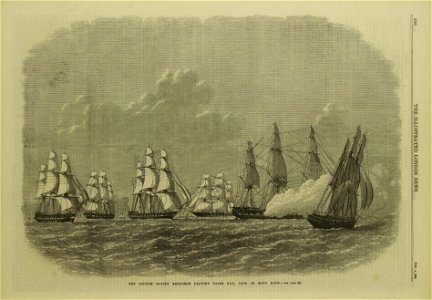The british flying squadron leaving false bay, cape of good hope. Illustration for the illustrated london news, 4 december 1869. Tee flying squadron at the cape. It was on oct. 3 that the flying squadron of the british fleet arrived at the cape of good hope. The frigate liffey, 35, captain j. O. Johnson, anchored in table bay, having left montevideo on sept. 11. The remainder of the squadron, under the command of admiral g. T. P. Hornby, and consisting of the liverpool, 35, captain j. O. Hopkins, and bearing the admiral's flag; the scylla, 21, captain herbert; the endymion, 21, captain lacey; the bristol, 31, captain f. W. Wilson; and the barrosa, 17, captain gibson, were in simon's bay, where were also the screw steam corvette rattlesnake, 17, captain william m. Dowell, c. B.;the screw steam gun-vessel pandora, 5, commander john burgess; the receiving-ship seringapatam, and the iron double-screw steam-tug african. The simon's bay anchorage, in false bay, is on the east side of the promontory formed by the table mountain and by the long narrow strip of rocky highland which stretches far southward to cape point. The port of table bay and the city of cape town are on the west side of the same promontory. When a north-west wind blows strong from the atlantic ocean, table bay is not a safe harbour, and the ships of the royal navy usually anchor in simon's bay. Our illustration, from a sketch by mr. Thomas charlton thompson, r. N. , of h. M. S. Rattlesnake, represents the departure of the flying squadron from false-bay, on oct. 18. The squadron is seen bearing down in two lines, with the liverpool leading, and carrying the flag of rear-admiral hornby, c. B. , commanding in chief. The ships are saluting his excellency sir philip wodehouse, the governor of cape colony, who had accompanied commodore w. M. Dowell, c. B. , in the rattlesnake, bearing the broad pennant, to see the squadron clear of the bay and to wish good-speed to their outward voyage. Page 567 of the iln. Date: 4 December 1869. Place of creation: London. Medium: wood engraving. Depicted Place: False Bay, Cape of Good Hope. The British Flying Squadron leaving False Bay, Cape of Good Hope - ILN 1869
Loading...
